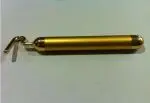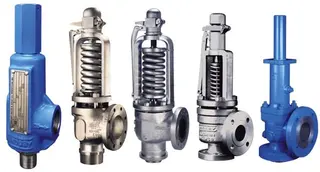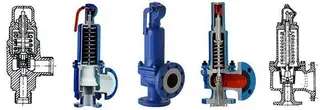Basic Knowledge of Brass (Part Three)
Tin Brass
Adding tin to brass can significantly improve heat resistance of the alloy, which can especially improve resistance of the alloy to sea water. Therefore, tin brass can also be called admiralty brass.
Tin can dissolve in the copper-based solid solution, playing a role of strengthening the solid solution. However, with the increasing tin content, the brittle r phase (the CuZnSn compound) appears in the alloy, which is not good for plastic deformation of the alloy. Thus, the tin content in tin brass is usually between 0.5% and 1.5%. The commonly used tin brass include HSn70-1, HSn62-1 and HSn60-1. HSn70-1 is α alloy, which has high plasticity. It can be processed by cold or hot press working. The other two alloys have the α plus β two-phase structure, and a small number of r phases often appear. The other two alloys have low plasticity at room temperature, and they can only be deformed in the hot state.
Manganese Brass
Manganese has greater solubility in the solid brass. Adding 1% to 4% manganese to brass can significantly improve strength and corrosion resistance of the alloy without reducing its plasticity. Manganese brass has the α plus β structure. Manganese brass has pretty good processability in the cold and hot state.
Iron Brass
Iron precipitates as the particle of the iron-rich phase in the iron brass. Iron as the crystal nucleus can refine grains and prevent recrystallized grains from growing so as to improve mechanical properties and processing properties of the alloy. The iron content in iron brass is usually below 1.5%, and iron brass has the α plus β structure, which make iron brass have good strength and toughness, good plasticity at high temperature and deformation also in the cold state. The common grade is the Hfe59-1-1.
Nickel Brass
Nickel and copper can form a continuous solid solution, which can significantly expand the α region. Adding nickel to brass can significantly improve corrosion resistance of brass in the atmosphere and seawater. Nickel can also increase recrystallization temperature of brass and facilitate the formation of smaller grains. HNi65-5 nickel brass has a single phase α structure, which makes nickel brass have good plasticity at room temperature and be deformed in the hot state. However, the content of lead impurities must be strictly controlled, or it will seriously deteriorate the thermal processing properties of the alloy.
Different Grades for Brass in Different Countries
Adding tin to brass can significantly improve heat resistance of the alloy, which can especially improve resistance of the alloy to sea water. Therefore, tin brass can also be called admiralty brass.
Tin can dissolve in the copper-based solid solution, playing a role of strengthening the solid solution. However, with the increasing tin content, the brittle r phase (the CuZnSn compound) appears in the alloy, which is not good for plastic deformation of the alloy. Thus, the tin content in tin brass is usually between 0.5% and 1.5%. The commonly used tin brass include HSn70-1, HSn62-1 and HSn60-1. HSn70-1 is α alloy, which has high plasticity. It can be processed by cold or hot press working. The other two alloys have the α plus β two-phase structure, and a small number of r phases often appear. The other two alloys have low plasticity at room temperature, and they can only be deformed in the hot state.
Manganese Brass
Manganese has greater solubility in the solid brass. Adding 1% to 4% manganese to brass can significantly improve strength and corrosion resistance of the alloy without reducing its plasticity. Manganese brass has the α plus β structure. Manganese brass has pretty good processability in the cold and hot state.
Iron Brass
Iron precipitates as the particle of the iron-rich phase in the iron brass. Iron as the crystal nucleus can refine grains and prevent recrystallized grains from growing so as to improve mechanical properties and processing properties of the alloy. The iron content in iron brass is usually below 1.5%, and iron brass has the α plus β structure, which make iron brass have good strength and toughness, good plasticity at high temperature and deformation also in the cold state. The common grade is the Hfe59-1-1.
Nickel Brass
Nickel and copper can form a continuous solid solution, which can significantly expand the α region. Adding nickel to brass can significantly improve corrosion resistance of brass in the atmosphere and seawater. Nickel can also increase recrystallization temperature of brass and facilitate the formation of smaller grains. HNi65-5 nickel brass has a single phase α structure, which makes nickel brass have good plasticity at room temperature and be deformed in the hot state. However, the content of lead impurities must be strictly controlled, or it will seriously deteriorate the thermal processing properties of the alloy.
Different Grades for Brass in Different Countries
| China GB |
Germany DIN |
Europe EN |
International Standard ISO |
The United States UNS |
Japan JIS |
||
| H96 | CuZn5 | 2.022 | CuZn5 | CW500L | CuZn5 | C21000 | C2100 |
| H90 | CuZn10 | 2.023 | CuZn10 | CW501L | CuZn10 | C22000 | C2200 |
| H85 | CuZn15 | 2.024 | CuZn15 | CW502L | CuZn15 | C23000 | C2300 |
| H80 | CuZn20 | 2.025 | CuZn20 | CW503L | CuZn20 | C24000 | C2400 |
| H70 | CuZn30 | 2.0265 | CuZn30 | CW505L | CuZn30 | C26000 | C2600 |
| H68 | CuZn33 | 2.028 | CuZn33 | CW506L | CuZn35 | C26800 | C2680 |
| H65 | CuZn36 | 2.0335 | CuZn36 | CW507L | CuZn35 | C27000 | C2700 |
| H63 | CuZn37 | 2.0321 | CuZn37 | CW508L | CuZn37 | C27200 | C2720 |
| HPb63-3 | CuZn36Pb1.5 | 2.0331 | CuZn35Pb1 | CW600N | CuZn35Pb1 | C34000 | C3501 |
| HPb63-3 | CuZn36Pb1.5 | 2.0331 | CuZn35Pb2 | CW601N | CuZn34Pb2 | C34200 | - |
| H62 | CuZn40 | 2.036 | CuZn40 | CW509N | CuZn40 | C28000 | C3712 |
| H60 | CuZn38Pb1.5 | 2.0371 | CuZn38Pb2 | CW608N | CuZn37Pb2 | C35000 | - |
| HPb63-3 | CuZn36Pb3 | 2.0375 | CuZn36Pb3 | CW603N | CuZn36Pb3 | C36000 | C3601 |
| HPb59-1 | CuZn39Pb2 | 2.038 | CuZn39Pb2 | CW612N | CuZn38Pb2 | C37700 | C3771 |
| HPb58-2.5 | CuZn39Pb3 | 2.0401 | CuZn39Pb3 | CW614N | CuZn39Pb3 | C38500 | C3603 |
| - | CuZn40Pb2 | 2.0402 | CuZn40Pb2 | CW617N | CuZn40Pb2 | C38000 | C3771 |
| - | CuZn28Sn1 | 2.047 | CuZn28Sn1As | CW706R | CuZn28Sn1 | C68800 | C4430 |
| - | CuZn31Si1 | 2.049 | CuZn31Si1 | CW708R | CuZn31Si1 | C44300 | - |
| - | CuZn20Al2 | 2.046 | CuZn20Al2 | CW702R | CuZn20Al2 | C68700 | C6870 |
Chemical Composition
| China | Japan | Germany | The United States |
UK |
| H62 | C2720 | CuZn40 | C27400 | CZ109 |
| H65 | C2680 | CuZn35 | C27000 | CZ107 |
| H68 | C2600 | CuZn30 | C26000 | CZ106 |
Japanese Grades
| Grade | Main composition | The content of the impurities % | Total impurities % | The corresponding Chinese grade | |||
| Cu | Zn | Pb | Fe | Ni | |||
| C2720 | 62-64 | Balance | ≤0.07 | ≤0.07 | -- | -- | HP62 |
| C2700 | 63-67 | Balance | ≤0.05 | ≤0.05 | -- | -- | H65 |
| C2680 | 64-68 | Balance | ≤0.05 | ≤0.05 | Bi≤0.002 | Sb≤0.005 | H68 |
| C2600 | 68.5-71.5 | Balance | ≤0.05 | ≤0.05 | -- | -- | H70 |
American Grades
| Grade | Main composition | The content of the impurities % | Total impurities % | The corresponding Chinese grade | |||
| Cu | Zn | Pb | Fe | Ni | |||
| C27400 | 61-64 | Balance | ≤0.10 | ≤0.05 | -- | -- | HP62 |
| C27000 | 63-68.5 | Balance | ≤0.10 | ≤0.07 | -- | -- | H65 |
| C26000 | 68.5-71.5 | Balance | ≤0.07 | ≤0.05 | -- | -- | H68, H70 |
Send your message to this supplier
Related Articles from the Supplier
Basic Knowledge of Brass (Part Three)
- Jan 30, 2018
Basic Knowledge of Brass (Part Two)
- Nov 24, 2017
Basic Knowledge of Brass (Part One)
- Nov 10, 2017
Related Articles from China Manufacturers
Basic knowledge of oil casing
- Jul 28, 2023
The Basic Knowledge of the Safety Valve (Part Three)
- Oct 24, 2017
Basic Knowledge of Safety Valves (Part Two)
- Sep 22, 2017
Basic Knowledge of Packing Seals
- Jul 31, 2025
Basic Knowledge of Safety Valves (Part One)
- Sep 08, 2017
Basic Knowledge of Kids Wear Fabric
- Apr 13, 2017
Related Products Mentioned in the Article
topper
- www.chinatopper.com
- Address: Xiamen
- Phone: 86-592-5819200
- Business Type: Trading, Industry & Trading, Manufacturer,
Supplier Website
Source: https://www.china-die-casting.com/basic-knowledge-of-brass-part-three.html


-150x145.webp)













